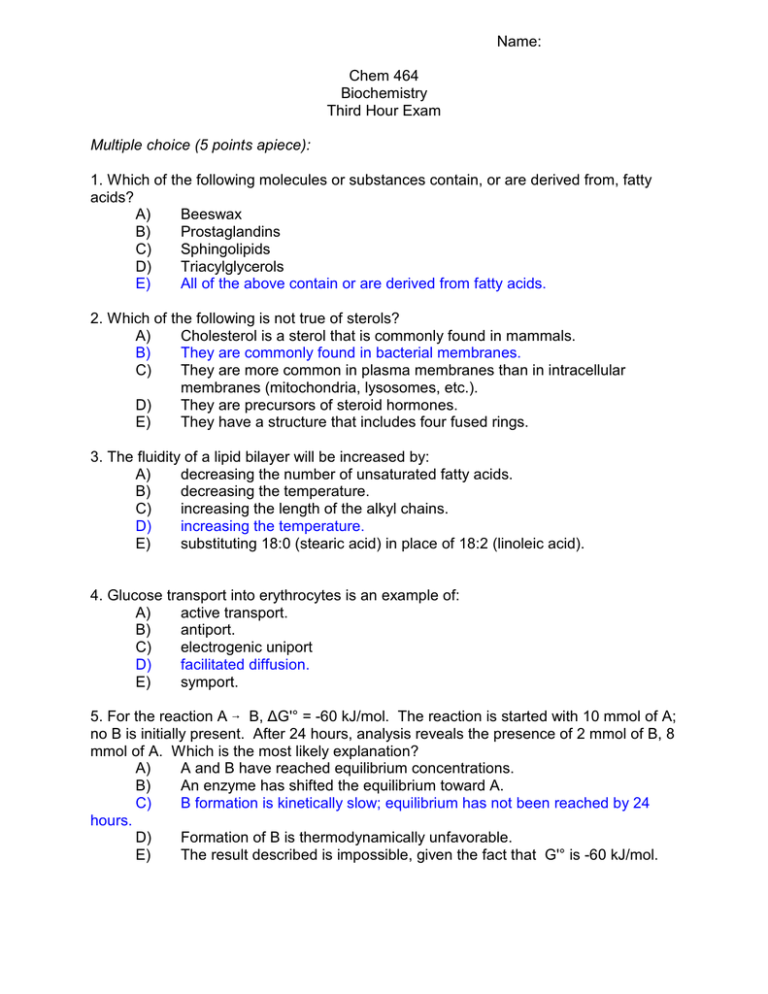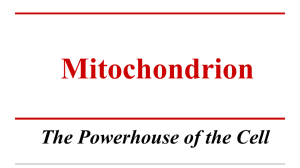Name: Chem 464 Biochemistry Third Hour Exam
advertisement

Name: Chem 464 Biochemistry Third Hour Exam Multiple choice (5 points apiece): 1. Which of the following molecules or substances contain, or are derived from, fatty acids? A) Beeswax B) Prostaglandins C) Sphingolipids D) Triacylglycerols E) All of the above contain or are derived from fatty acids. 2. Which of the following is not true of sterols? A) Cholesterol is a sterol that is commonly found in mammals. B) They are commonly found in bacterial membranes. C) They are more common in plasma membranes than in intracellular membranes (mitochondria, lysosomes, etc.). D) They are precursors of steroid hormones. E) They have a structure that includes four fused rings. 3. The fluidity of a lipid bilayer will be increased by: A) decreasing the number of unsaturated fatty acids. B) decreasing the temperature. C) increasing the length of the alkyl chains. D) increasing the temperature. E) substituting 18:0 (stearic acid) in place of 18:2 (linoleic acid). 4. Glucose transport into erythrocytes is an example of: A) active transport. B) antiport. C) electrogenic uniport D) facilitated diffusion. E) symport. 5. For the reaction A 6 B, ÄG'° = -60 kJ/mol. The reaction is started with 10 mmol of A; no B is initially present. After 24 hours, analysis reveals the presence of 2 mmol of B, 8 mmol of A. Which is the most likely explanation? A) A and B have reached equilibrium concentrations. B) An enzyme has shifted the equilibrium toward A. C) B formation is kinetically slow; equilibrium has not been reached by 24 hours. D) Formation of B is thermodynamically unfavorable. E) The result described is impossible, given the fact that G'° is -60 kJ/mol. 6. The standard free-energy changes for the reactions below are given. Phosphocreatine 6 creatine + Pi ÄG'° = -43.0 kJ/mol ATP 6 ADP + Pi ÄG'° = -30.5 kJ/mol What is the overall G'° for the following reaction? Phosphocreatine + ADP 6 creatine + ATP A) B) C) D) E) -73.5 kJ/mol -12.5 kJ/mol +12.5 kJ/mol +73.5 kJ/mol G'° cannot be calculated without Keq'. Essay type questions (10 points each) 7. A common procedure for cleaning the grease trap in a sink is is to add a product (like Draino) containing NaOH. Explain why this works. The grease in a sink trap would be triacylglycerols. Adding the NaOH begins to hydrolyze the triacyl glycerols into glycerol and individual fatty acids. This will lower the meltng point of the material and make it more fluid so the clog can be released. 8. A. How are triacylglycerols, glycerophospholipids, and galactolipids similar? How are they different? All three of these have a glycerol backbone connected to at least 2 fatty acids. Triacyl glycerols, where are a storage lipid would have a third fatty acid connected to this base. Glycerophospholipids, which are membrane lipids out have a phosphate attached to the base, and then various other compounds attached to the phosphate. Galactolipids, used in plant membranes would have one or two galactose molecules attached to the base. B. How are sphinolipids classed as phospholipids and sphinolipids classed as glycolipids similar? How are they different? Both would contain sphingosine as the base molecule as well as a fatty acid connected to the sphingosine in an amide linkage. In sphingomyelins, which are prominent in neurons, a phosphate and either choline or ethanolamine are attached to this base. In glycosphingolipids, which are a dominant lipid on the outside of plasma membrane, there is no phosphate, but one or more sugars are attached. 9. Describe general structural features of an integral membrane protein. How is this different than the structure of a water soluble enzyme? In water soluble enzymes all the hydrophoic residues are buried in the interior of the protein where they cannot interact with the surroundings, and the surface of the is covered with polar and charged residues. Membrane proteins, which have to interact with the lipid bilayer will have exposed hydrophobic residues on all surfaces that contact the membrane. Although some membrane proteins are built around membrane spanning beta-barrels, the most common structure is a membrane spanning helix of 2030 residues. Other features often see in integral membrane proteins are a large number of tyrosine and tryptophan right at the membrane/water interface, and lys, arg, and his residues on the cytoplasmic side of the membrane. 10. In Chapter 11 you examined four different types of ATPases involved in active transport. Briefly describe each of these types of transporters. P-type ATPases are reversibly phosphorylated by ATP as part of transport. They have similar sequences, especially near ASP that is phosphoryated. They are also sensitive to inhibition by Vanadate . F Type ATPases are used in mitochondria and chloroplast for ATP synthesis. They are not phosphorylated as part of their mechanism, and are non inhibited by Vanadate. While they can use ATP energy to pump protons out of an organelle, their actual biological function is to let protons into an organelle and use this as an energy source to make ATP. V-type ATPases - Structurally and perhaps mechanistically similar to F-type, but instead of using the proton gradient to make ATP, they use ATP energy to create the proton gradient. They are not phosphorylated as part of their mechanism, and are non inhibited by Vanadate. ABC Transporters - A large family of ATP dependent transporters that move ‘stuff’ out of cell. All share a common ATP Binding Cassette, hence the name ABC transporter. All ABC’s have2 nucleotide binding domains (NBD’s) and 2 transmembrane domains. 11. In Chapter 12 you were asked to study any one of the six general types signal transduction system on your own. Tell me about what you learned. Answers were checked against the book for accuracy and completeness. Diagrams help! 12. Define the following terms: Internal energy E sum of knetic and potential energy of all particles in a system. ÄG Free energy or Gibbs free energy. Energy available to do work ÄH-TÄS homolytic cleavage (of a C-C bond) Cleavage of a C bond where one electron of the bond stays with each C that was involved in the bond. Carbanion An anion in which a C atom carries a negative charge. Group transfer reaction A reaction in which a functional group like a phosphate or a sugar moiety are transferred from one compound to another. 13. The ÄGo’ for ATP hydrolysis is given as -35 kJ/mol @298K. Calculate the actual free energy of hydrolysis for ATP in a rat neuron where [ATP] = 2.59 mM,[ADP]=.73 mM and [Pi]=2.72 mM. From this ÄG, calculate the K for this reaction. My wording on the last part of this question is a bit misleading. ÄG’0= -RT ln K My wording implied that you should use the ÄG you just calculated instead of ÄG’o which is not correct. If you made that mistake, I did not take any points off because of the way I worded the question. 1E 2B 3D 4D 5C 6B





